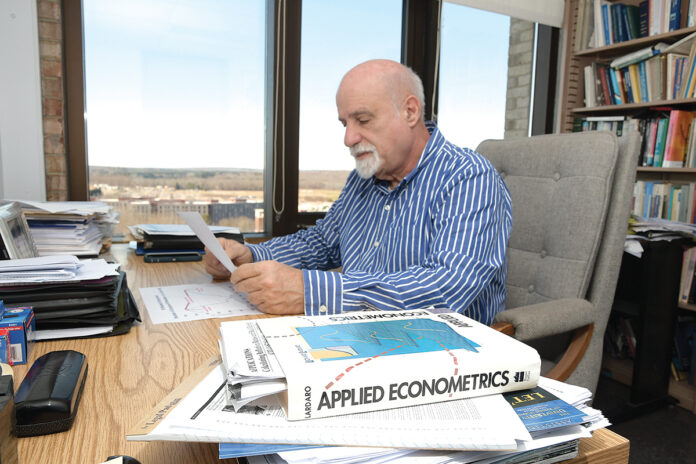Rhode Island has cranes in the sky, unemployment below 4%, new companies such as Infosys Ltd. and new jobs have arrived in its capital city.
What could go wrong?
The national economy, of course. As the U.S. economy goes, so goes Rhode Island, and nothing has insulated the Ocean State from being dragged into a possible malaise, according to local economists.
The state’s employment picture, once dire, improved to 3.5% unemployment in October, which would seem to be nearly full employment.
But economists say to get a clear picture, the unemployment rate isn’t as effective as it once was as an economic indicator. It only measures those Rhode Islanders who are unemployed and actively seeking employment. And it includes part-time jobs, which may not pay well and don’t truly reflect full employment.
Another statistic, labor force participation, has dropped this year in Rhode Island, and remains below the 2006, pre-Great Recession level, according to Leonard Lardaro, an economist and professor at the University of Rhode Island.
Labor participation is the percentage of the state’s working-age population that has a job. The latest figure, in October, put it at 64.4%, well below the peak of 68.6% in January 2007.
Lardaro tracks the statistic monthly in his Current Conditions Index. The snapshot of 64% participation looks grim to him.
“Our participation rate is still well below what it was in 2006,” he said. “It means a lot of things. People might be doing the gig economy, but that’s not huge. Some people don’t have the skills and they’re dropping out.”
The state remains what he calls FILO – first in and last out of recession, he said. But the downward cycle will likely not be as bad the next time.
Lardaro said the Great Recession was unusual in that it was fed by the failure of financial institutions and the collapse of the housing market. Those industries are stable 13 years later, and while some negatives are creeping in again, such as subprime lending, it’s not to the extent of the early 2000s.
‘Last time was a ton of bricks when the financial markets collapsed.’
LEONARD LARDARO, economist and University of Rhode Island professor
On a worrisome note, he said American consumers and businesses are more deeply in debt than they were before the Great Recession. That leaves them little flexibility to recover if the economy starts to slow significantly.
But the state is in a better position overall to weather a recession because it’s likely to come on gradually.
“The next recession is going to be very different from the last one,” he said. “Therefore, that’s going to make us better positioned. Last time was a ton of bricks when the financial markets collapsed. That’s not going to happen. Whatever happens will be more gradual.”
Edward M. Mazze, distinguished professor of business administration at the University of Rhode Island, is more upbeat. There is no question that Rhode Island is in a stronger position now post-recession, he said.
But Mazze sees worrisome trends in the mix of Rhode Island businesses. Unlike many states, the Ocean State is dominated by small business. And not even 200 employees or under, which is the federal definition. Most local businesses have fewer than 50 employees, and half of those employ only the owner.
This leaves the state vulnerable because many of these small businesses may close. Regional retail chain Benny’s is probably the most recent example of a business that simply shut its doors, albeit with 700 employees. It closed in December 2017.
“The big problem you have in Rhode Island is the demographic of the owner getting older,” Mazze said. “They have an option of just closing the door and retiring. They can look for a new buyer. But if they don’t find a buyer, all they have to do is lock the door.”
In other states, if 100 people are laid off, it’s not big news. It is in Rhode Island, Mazze observed.
“Everybody in a small business may have a secretary,” he said. “If a secretary is laid off, that has an impact on the economy. Every job matters.”
In addition to the overdependence on small business, Rhode Island’s larger companies tend to have their headquarters elsewhere. That leaves the state vulnerable to employment relocations and reductions.
“The decisions they make are made somewhere else,” Mazze said.
On a positive note, Mazze said the state is now led by officials who have an understanding of economic development, at least more so than they did 10 years ago. And the medical and education industries are experiencing growth, as evidenced by building projects such as the South County Wellness Center, opened in 2016 by South County Health, in Westerly, he said.
Still, there is the issue of population. Rhode Island’s growth is close to being stagnant. Statistically, Lardaro pointed out, the residential population may actually be declining because the percentage increase is within the margin of error.
Said Mazze: “In a state where there is virtually no population growth, you’re not going to see celebrating in the street. But one of the big differences is that 10 years ago … one-third of the working population of Rhode Island was either unemployed or underemployed. You can’t say that now.”
Mary MacDonald is a PBN staff writer. Contact her at Macdonald@PBN.com.













Why do people listen to this Ladaro guy? He is purely political. His opinions are rarely grounded in sound economics. He says don’t pay attention to the low RI unemployment rate. Instead pay attention to our Participation rate which is 64.4%. He leaves out the fact that this is significantly better than the national average which is currently at 63.2%.